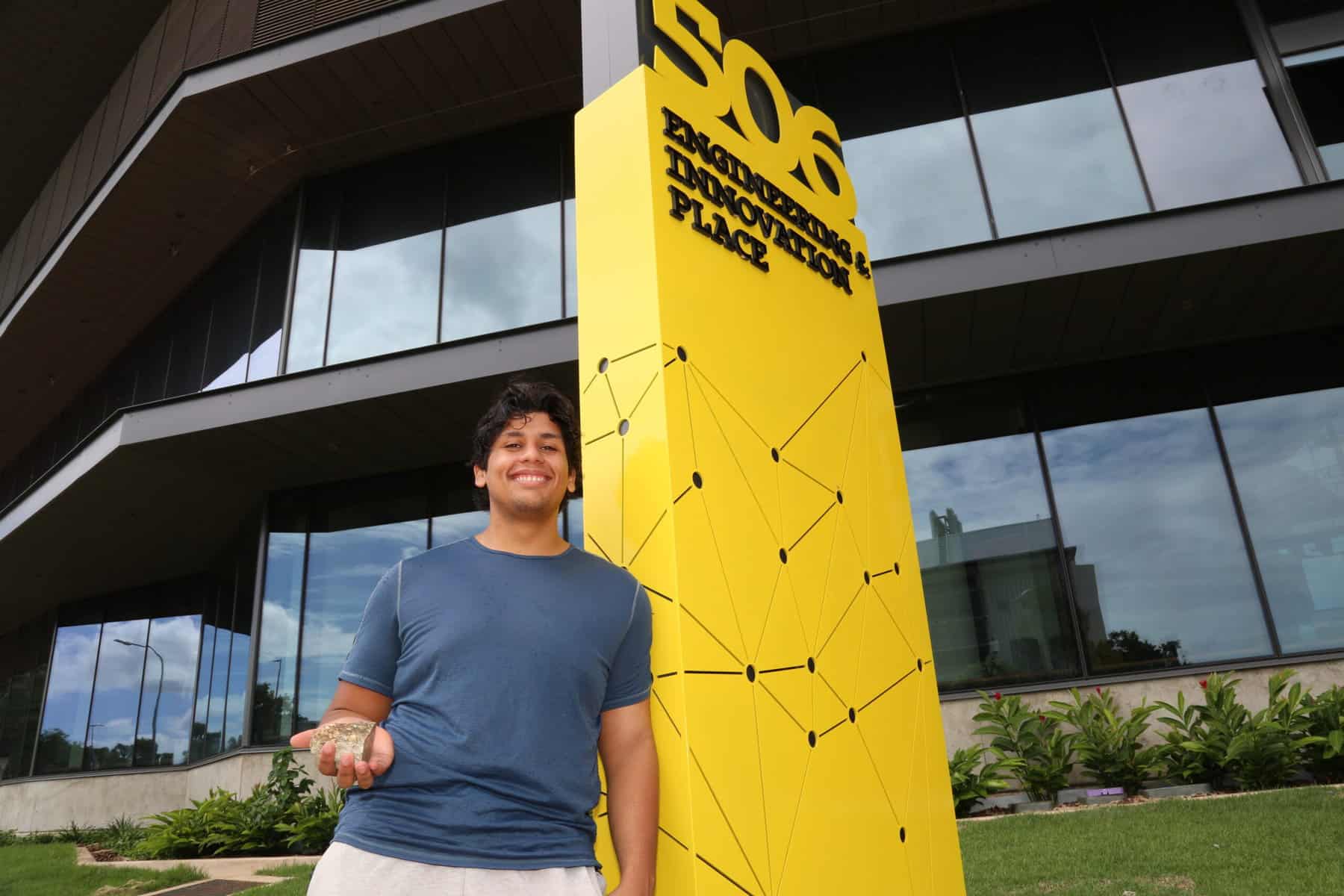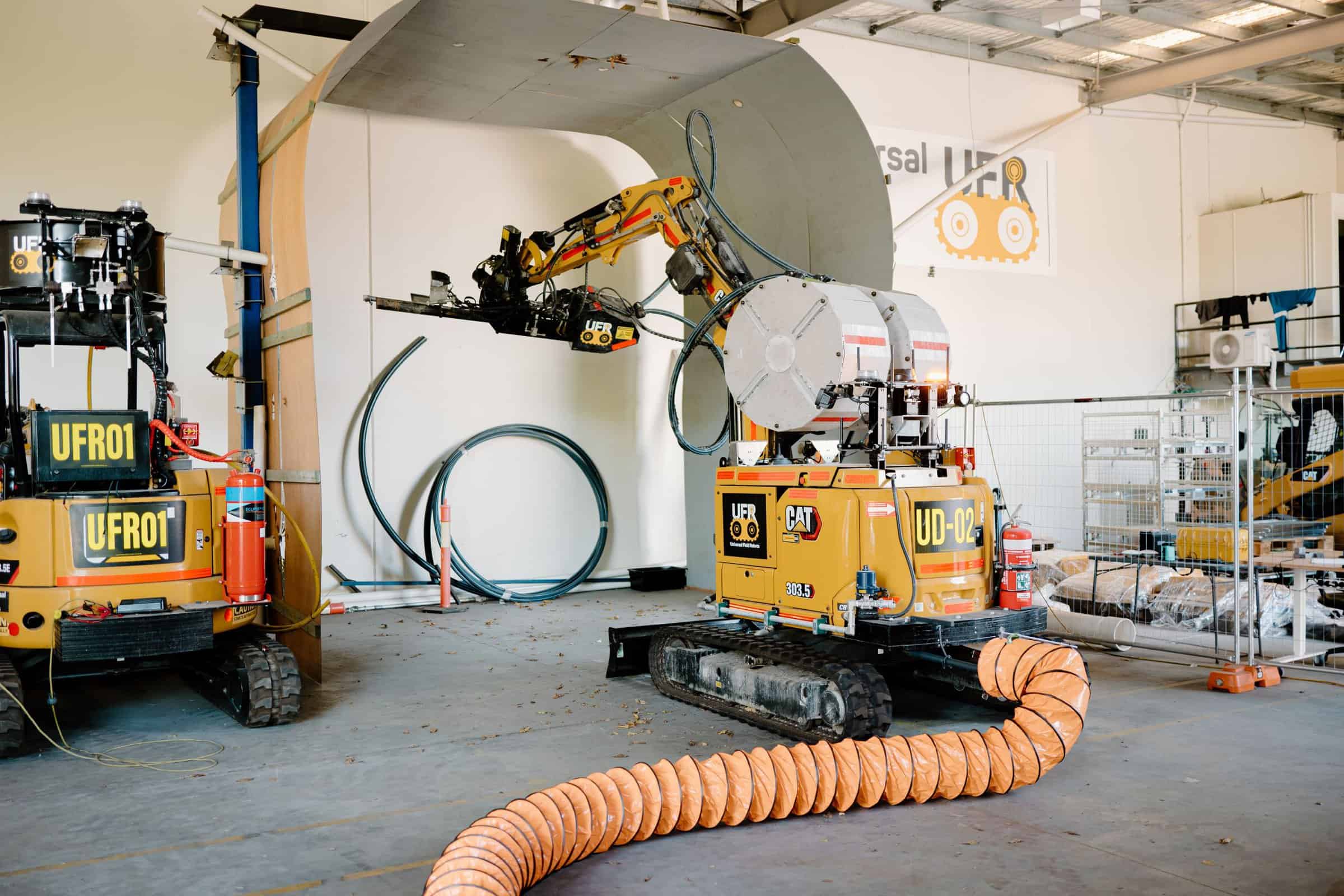Universal Field Robots – Australia’s Robotics and Automation R&D Powerhouse

Although starting out in the competitive and price sensitive world of agriculture, Universal Field Robots (UFR), has become synonymous with mining. Its early innovations in lawn-mowing robots and avocado picking laid the foundation for a more innovative approach to technology as it transitioned into other industrial segments. The company’s commitment to technological advancement led to the introduction of UFRautonomy™, a reflection of the continuous evolution in its architecture and technology stack.
UFR has quickly gained recognition as an R&D leader in the field of robotics and automation, facilitating its expansion across several industries including mining, solar farm construction, and defence.
The partnership with Newmont Cadia marked a significant milestone, one that resulted in the development of an automated Bobcat Skid Steer with an integrated EPIROC safety system. This successful collaboration not only set a new standard for interoperability in the industry, but highlighted UFR’s exceptional integration skills and ability to make any OEM platform or machine autonomous.
A successive partnership with IMDEX saw the development of BLAST DOG™, an autonomous system for multi-parameter measurement of blast holes. This showcased UFR’s strategic approach of utilising proven and robust platforms, notably the two-tonne Caterpillar excavator as the basis for their robots.
Leveraging ROS/ROS2 as the core robotics software development platform, UFR streamlined development processes and introduced the concept of OEM-agnostic integration. This approach allowed UFR to rapidly develop and deploy autonomous solutions across different industries, further strengthening its position as a leader in the field of robotics and automation.
The role of interoperability in mining automation
The latest industry data highlights Australia’s mining industry accounts for 14.3 percent of GDP, and contributed A$455 billion in export revenue in the 2022-23 financial year. It’s therefore no surprise that companies are embracing automation and new technologies to improve the performance of their assets.
“The accelerated shift into robotics and automation by Australia’s miners has been in response to the fact their operations are typically situated in remote locations, which presents additional challenges in the area of digital connectivity and integration,” said UFR Managing Director Jeff Sterling.
“Automation, digitisation, and integration initiatives are now at the forefront of most mining companies’ technological roadmaps. Interoperability is a necessity in order to achieve success, and building an interoperable future can only be solved via strategic collaboration and communication.”
Autonomous mining equipment, such as drills, require constant communications. Given the remoteness and distributed nature of most mine sites, poor connectivity or potential failure can result in costly downtime.
Autonomous teleremote tracked machines such as robots that act as a radio point of presence can drive to a location on the mining bench to support autonomous drills. Once they reach the target location, the machine establishes a high bandwidth microwave data link with the mine network and extends a tall mast to rebroadcast radio coverage to the drills. When a blast is scheduled, the machine can drive from the bench to a safe place away from the blast. The robots can also be fitted with a pan tilt zoom camera on the mast, allowing remote control room operators to observe activity from a high vantage point and ensure the safety and security of their drilling machinery and operations.
UFR’s suite of autonomous capabilities, from autonomous haulage and mission planning to object detection and collision avoidance, play a critical role in its transformation into OEM agnostic and interoperable automation.
In 2022, Gold Fields sought an automation partner with interoperability capabilities and an industry-leading technology stack. Despite a competitive field that included top-tier OEMs and well-established technology suppliers offering teleremote solutions, UFR proved the partner of choice.
Mr Sterling explained that their comprehensive technology stack coupled with robust engineering capabilities were a powerful combination in Gold Fields’ decision-making process.
“Our ability to deliver a tailored OEM Agnostic offering aligned perfectly with their specific operational requirements,” he said. “This collaboration underscored our reputation as a leader in the field, with a broad capability to deliver cutting-edge technologies and expertise that meets the evolving demands of the mining industry.”
However, the transition to autonomy faces a number of obstacles like limited availability and compatibility among OEMs. Challenges include limited autonomy options, brand-specific solutions hindering interoperability, proprietary software restricting integration, complex and costly integration processes, and vendor lock-in stifling innovation.
As a result, customers are seeking out open platforms for flexibility. And addressing these challenges requires collaboration among OEMs, technology providers, and customers in order to develop standardised interfaces, protocols, and integration frameworks that facilitate seamless interoperability and compatibility across autonomous systems.
Open standards and modular architectures can help mitigate vendor lock-in and provide customers flexibility in the selection and integration of best-of-breed autonomy solutions that meet their specific requirements and preferences.
“UFR serves as the ‘interoperable glue’ connecting OEM vehicles to autonomous systems across many OEMs and tech providers,” added Mr Sterling.
“Our unique expertise integrating OEM vehicles that enables autonomy and connects them to other operation enabling technologies, we provide seamless interoperability and bridge the gap between disparate systems.
“By adopting an open architecture approach, we facilitate this integration via a range of autonomous systems and coordination software. Our modular solutions allow easy integration into existing infrastructure, which reduce complexity and disruption.”
ESG and Autonomy
Integrated digital technology not only enables operators to make faster decisions but also aids assets in achieving Environmental, Social, and Corporate Governance (ESG) objectives by reducing their carbon footprint. Research indicates that incorporating autonomous truck fleets can yield a 10-15 percent emissions reduction, primarily through route optimisation, speed control, and fuel efficiency enhancement.
- Optimised Routes: Real-time data analysis by autonomous systems identifies the most efficient transport routes within mine sites.
- Consistent Speeds: Autonomous trucks maintain steady speeds and acceleration, enhancing fuel efficiency compared to human-driven vehicles.
- Energy Management: Autonomous systems optimise energy strategies like regenerative braking, reducing fuel consumption and emissions.
- Dynamic Fleet Management: Autonomous fleets adjust to production demand, minimising idle time and emissions.
- Predictive Maintenance: Real-time monitoring detects maintenance issues early, improving vehicle performance and reducing emissions.
Underground Autonomous Haulage
Gold Fields sought an interoperable, OEM-agnostic automation solution to upgrade their Epiroc MT65 underground haul trucks and integrate with other site-based technologies. Leveraging UFRautonomy™, the first automated truck achieved line-of-sight teleremote capability within 5 weeks, progressing to Technology Readiness Level 7 over seven months.
After a successful factory acceptance test, fine-tuning took place over a two-month period. The truck underwent underground testing, and refinement with UFR’s adaptable UFRautonomy™ system, which facilitated rapid integration of enhanced perception sensors. Scheduled autonomous material haulage is expected by Q2 2024.
“Our project with Gold Fields is advancing at a steady pace,” said Mr Sterling. Preparations for installing three additional trucks are currently underway and we’re targeting completion by Q3 2024.
UFR’s future roadmap incorporates the launch of autonomous haulage over shift change and the development of a robot orchestration system for coordinating underground autonomous trucks.
UFR AutoPrep
As the global commitment to achieving net-zero emissions intensifies, the mining industry faces unprecedented challenges in meeting heightened demand for resources while prioritising safety and efficiency.
To address this gap, UFR is pioneering the development of UFR AutoPrep, the world’s first automated production drillhole preparation and survey robot. By leveraging the state-of-the-art UFRautonomy™ stack, the company is transforming a traditionally labour-intensive process into a streamlined, safer operation.
UFR have partnered with Gold Fields to pilot, refine and develop the hole preparation and survey solution, and in the future it will extend the robot’s capabilities to encompass initiation system placement and charging.
“AutoPrep’s beachhead market are sites with challenging conditions such as high temperatures, unstable ground conditions, high silica dust or high lead content,” said Mr Sterling.
“The technology plays a pivotal role in improving operational efficiency and safety in mining operations. By reducing the personnel required for the task from three to just one operator, it optimises resource allocation and minimises labour costs.”
Operators also benefit from greater comfort and safety measures, starting in air-conditioned cabs and transitioning to air-conditioned offices behind a control desk. This not only ensures a conducive working environment, but underscores UFR’s commitment to prioritising the wellbeing of its operators.
After two years of intensive design, development, and iterative refinement, coupled with extensive field testing and comprehensive operator feedback, UFR have reached a significant milestone in their journey. Drawing upon invaluable performance data and insights, the team are now building a Minimum Viable Product (MVP).
“Our MVP design concept is based on a CAT wheel loader as its foundation,” said Mr Sterling. “This choice speeds up tramming times and extends the reach of our solution, all of which enhancing operational efficiency. This culmination of research, iterative development, and real-world testing, positions us at the forefront of innovation in the mining industry.”
UFR have secured their first trial site for 2025, and are seeking additional customers to participate in site trials. The company’s roadmap includes the integration of an appropriate survey tool into their solution. By leveraging survey data, UFR can augment the value proposition to customers by providing insights into blast hole deviations and enhancing orebody knowledge.
Autonomous placement of the initiation system and autonomous charging of blast holes are significant advancements in UFR’s journey ahead. By integrating autonomous technology into these critical processes, the company aims to revolutionise the blasting workflow, streamline operations, and increase precision, while minimising human intervention.
 UFR AutoFuel
UFR AutoFuel
The Australian Defence Force is confronted with manual infield refuelling processes that carry significant risks and inefficiencies, which compromises personnel safety and consume valuable operational time. Addressing these challenges and bolster safety protocols requires direct human involvement in such hazardous tasks to be minimised.
An effective solution is AutoFuel, which is an advanced autonomous refuelling system developed in collaboration with ECLIPS Logistics. It eliminates the need for military personnel to engage in refuelling tasks by leveraging computer vision, machine learning and the use of UFRautonomy™ technology.
After a comprehensive market research study, coupled with thorough evaluation of various industrial robotic arm solutions, UFR embarked on developing its own hydraulic arm capable of withstanding harsh environmental conditions.
“While precise movement posed a challenge, our engineers developed a hydraulic arm capable of remarkable accuracy and agility,” said Mr Sterling. “It boasts an impressive capacity to endure heavier workloads compared to off-the-shelf industrial robotic arms of similar size, which offers new levels of durability and performance in demanding operational environments.”
He added that the next phase of UFR’s development involves refining the hydraulic arm and subjecting it to rigorous field testing in collaboration with the defence industry.
“This strategic initiative aims to validate the arm’s performance and durability in real-world scenarios, ensuring its readiness to meet the specific requirements of military operations. Partnering with the defence industry for field testing is testament to our commitment to delivering a reliable and robust solution that meets the highest standards of quality and reliability.”
UFR are currently assessing the market potential for deploying AutoFuel in refuelling applications within mining operations. The company has been approached by key mining stakeholders to adapt its hydraulic arm for handling large batteries in Battery Electric Vehicles. This involves collaborating with Tier 1 companies to progress the initial scoping stage for each solution, a move that underscores the diversification of its solutions aligned to the evolving needs of the industry.
For more information, email [email protected] or visit https://universalfieldrobots.com.au/


































 UFR AutoFuel
UFR AutoFuel




